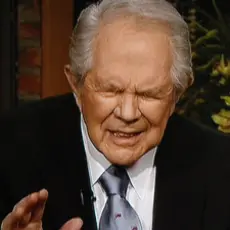Bill Sizemore, a reporter for The Virginian-Pilot, probably knows as much as anyone about Pat Robertson and his multi-million dollar empire, having covered him for years and regularly breaking stories on everything from his outrageous statements to his murky business dealings.
Recently, Sizemore penned an insightful and informative profile of the Religious Right icon for the Virginia Quarterly Review that not only chronicles Robertson’s rise to fame and wealth but also serves as an excellent example of the sort of pieces Sizemore has done on Robertson over the years, which helps explain why Robertson hates him so much.
I spoiled Pat Robertson’s birthday.
I know, because he told me so.
On March 22, 2007, the day he turned seventy-seven, the televangelist and I sat eyeball-to-eyeball across the corner of a long table in a dark-paneled conference room at the Christian Broadcasting Network’s cross-shaped headquarters in Virginia Beach. Also at the table were two CBN lawyers and the editor, publisher, and lawyer from the newspaper I write for, the Virginian-Pilot. We had been summoned for a tongue-lashing over a story I had written about Robertson. It was a vicious piece, full of lies, he fumed—and what’s more, I had consciously timed its appearance to ruin his birthday. He demanded a retraction, a correction, an apology. If he didn’t get it, he implied none too subtly, he would sue.
“You guys are as crooked as a snake,” he sputtered. “I’ll have you all in depositions for the rest of your life.”
Sizemore explains how Robertson, son of a US Senator, set out to be a “sophisticated New York swinger,” only to jettison the lifestyle in pursuit of the “prosperity gospel,” the idea that believers will be rewarded financially for their faith in God … and, more importantly, their monetary donations to his servants such as Robertson.
The piece chronicles Robertson’s early days of speaking in tongues, casting out demons, fighting off Satan, and warding off hurricanes through his purchase of a bankrupt TV station in southern Virginia that eventually became the behemoth Christian Broadcasting Network. Along the way, Robertson developed close ties with now-disgraced evangelist Jim Bakker and slowly began transforming his growing ministry into a political force that culminated in his failed run for President in 1988 and the eventual birth of the Christian Coalition.
Sizemore also lays out Robertson’s shady business practices, noting how raised money for his charity Operation Blessing by promising to provide aid to the victims of the genocide in Rwanda in 1994 … and then proceeded to use the operation to mine for diamonds in the Democratic Republic of Congo [formerly Zaire] for the benefit of his for-profit African Development Company. When Sizemore broke the story, Robertson was livid and when the two met years later, Robertson still had not forgiven him:
The publicity cost him a bundle, he complained, and the crowning indignity was the venture’s meager output. “We got one tiny little diamond!” he exclaimed.
Sizemore goes on to examine everything from Robertson’s ties to indicted Liberian war-criminal Charles Taylor to the founding of his Regent University Law School and the subsequent influence its 150 graduates had within the Bush Administration.
But perhaps the most interesting anecdote comes from Gerry Straub, a former “700 Club” producer, who explained how Robertson and his supporters believe that CBN had been chosen by God to “usher in the coming of my Son” and, as such, put in place a plan to televise Christ’s imminent return to earth:
In order to prepare for the imminent Second Coming—which Robertson believes will occur on the Mount of Olives in Jerusalem according to biblical prophecy—he acquired METV (Middle East Television), a station then based in southern Lebanon that could broadcast into Israel. Straub was given marching orders to be ready to televise Christ’s return. CBN executives drew up a detailed plan to broadcast the event to every nation and in all languages. Straub wrote: “We even discussed how Jesus’ radiance might be too bright for the cameras and how we would have to make adjustments for that problem. Can you imagine telling Jesus, ‘Hey, Lord, please tone down your luminosity; we’re having a problem with contrast. You’re causing the picture to flare.’”
As Sizemore notes, it might be tempting to write Robertson off as a now-inconsequential relic, but to do so greatly underestimates Robertson’s continuing influence, as well as the legacy he has created:
Perhaps of most import for the nation and the world, he has pioneered a unique marriage between theology and politics. This is a man who ran for president because, he said, God told him to, but that brief campaign twenty years ago would be merely a footnote in American political history were it not for the potent legacy it spawned.
Robertson has never really left the political stage. He opines on world events daily on his TV show and regularly interviews national and world leaders. Presidential hopefuls give major speeches at Regent University, the school he founded, where former attorney general John Ashcroft is on the faculty. Out of the ashes of the Robertson presidential campaign came an army of Bible-believing religious fundamentalists which has won a degree of political power unprecedented in modern times.







